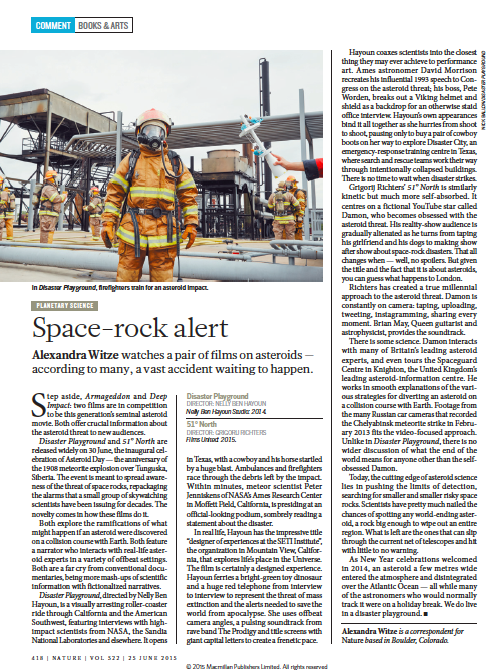Review of Disaster Playground in Nature Magazine by Alexandra Witze . Read the full article here
Step aside, Armageddon and Deep Impact: two films are in competition to be this generation’s seminal asteroid movie. Both offer crucial information about the asteroid threat to new audiences. Disaster Playground and 51° North are released widely on 30 June, the inaugural celebration of Asteroid Day — the anniversary of the 1908 meteorite explosion over Tunguska, Siberia. The event is meant to spread awareness
of the threat of space rocks, repackaging the alarms that a small group of skywatching scientists have been issuing for decades. The novelty comes in how these films do it. Both explore the ramifications of what might happen if an asteroid were discovered on a collision course with Earth. Both feature a narrator who interacts with real-life asteroid experts in a variety of offbeat settings.
Both are a far cry from conventional documentaries, being more mash-ups of scientific information with fictionalized narratives.
Disaster Playground, directed by Nelly Ben Hayoun, is a visually arresting roller-coaster ride through California and the American
Southwest, featuring interviews with highimpact scientists from NASA, the Sandia National Laboratories and elsewhere. It opens in Texas, with a cowboy and his horse startled by a huge blast. Ambulances and firefighters race through the debris left by the impact.
Within minutes, meteor scientist Peter Jenniskens of NASA’s Ames Research Center in Moffett Field, California, is presiding at an official-looking podium, sombrely reading a statement about the disaster. In real life, Hayoun has the impressive title “designer of experiences at the SETI Institute”, the organization in Mountain View, California, that explores life’s place in the Universe.
The film is certainly a designed experience.
Hayoun ferries a bright-green toy dinosaur and a huge red telephone from interview to interview to represent the threat of mass extinction and the alerts needed to save the world from apocalypse. She uses offbeat camera angles, a pulsing soundtrack from rave band The Prodigy and title screens with giant capital letters to create a frenetic pace. Hayoun coaxes scientists into the closest thing they may ever achieve to performance
art. Ames astronomer David Morrison recreates his influential 1993 speech to Congress on the asteroid threat; his boss, Pete Worden, breaks out a Viking helmet and shield as a backdrop for an otherwise staid office interview. Hayoun’s own appearances bind it all together as she hurries from shoot to shoot, pausing only to buy a pair of cowboy boots on her way to explore Disaster City, an emergency-response training centre in Texas,
where search and rescue teams work their way through intentionally collapsed buildings. There is no time to wait when disaster strikes.
Today, the cutting edge of asteroid science lies in pushing the limits of detection, searching for smaller and smaller risky space rocks. Scientists have pretty much nailed the chances of spotting any world-ending asteroid, a rock big enough to wipe out an entire region. What is left are the ones that can slip through the current net of telescopes and hit with little to no warning. As New Year celebrations welcomed in 2014, an asteroid a few metres wide entered the atmosphere and disintegrated over the Atlantic Ocean — all while many of the astronomers who would normally track it were on a holiday break.
We do live in a disaster playground.
Alexandra Witze is a correspondent for Nature based in Boulder, Colorado.
Disaster Playground
DIRECTOR: NELLY BEN HAYOUN
Nelly Ben Hayoun Studio: 2014.
